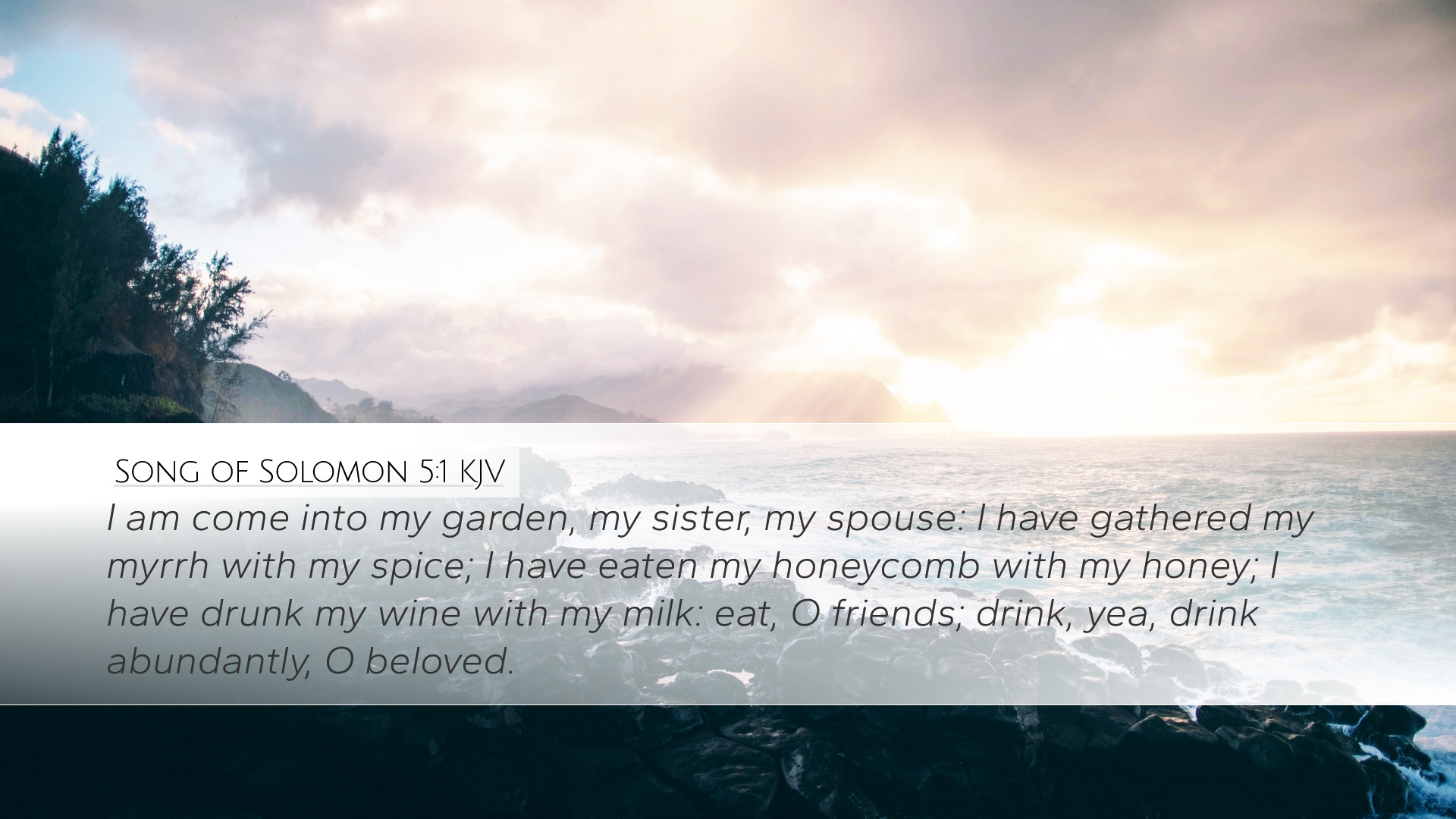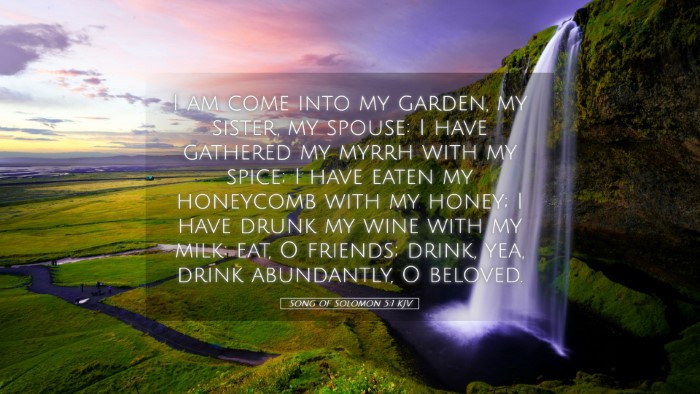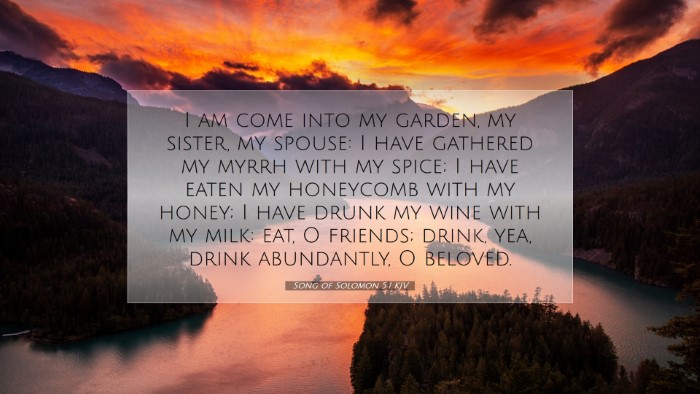Commentary on Song of Solomon 5:1
Verse: "I am come into my garden, my sister, my spouse: I have gathered my myrrh with my spice; I have eaten my honeycomb with my honey; I have drunk my wine with my milk: eat, O friends; drink, yea, drink abundantly, O beloved."
Introduction
The Song of Solomon, also known as the Song of Songs, is a poetic exploration of love and desire between a bride and groom. In 5:1, the imagery of a garden embodies intimacy and fulfillment. This passage opens a window into both the joys of marital love and the spiritual dimension of communion between Christ and His Church. Notably, the verse serves as a closing for the preceding discourse and emphasizes the fruitful rewards of love.
Exegesis of the Text
This verse is rich with imagery and metaphor. The garden symbolizes a place of delight where love can flourish. The inclusion of flavors like honey and wine suggests both sweetness and joy, emphasizing the abundant blessing found in love.
Key Elements of the Verse
- “I am come into my garden”: This statement reflects intimate connection and belonging. The speaker, identified as the Beloved, approaches with the expectation of fellowship and pleasure.
- “my sister, my spouse”: The dual title of sister and spouse suggests closeness and depth in relationship. This dual nature indicates both the familial bond and the romantic union, reflecting the multifaceted nature of love.
- “I have gathered my myrrh with my spice”: The gathering of myrrh and spice symbolizes the fruits of love and labor in the relationship. Both myrrh and spices have implications of sacrifice and richness, indicating the valuable nature of the bond.
- “I have eaten my honeycomb with my honey”: Honeycomb and honey represent pleasure and sustenance. This imagery conveys the fulfillment found in love along with the remarkable taste of companionship.
- “I have drunk my wine with my milk”: The combination of wine and milk suggests complexity and fullness. Wine often denotes joy and celebration, while milk denotes nourishment, illustrating a complete experience.
- “eat, O friends; drink, yea, drink abundantly”: The invitation emphasizes communal joy and fellowship. The Beloved opens the experience of love and abundance to others, reflecting the nature of love that invites participation and joy in community.
Theological Insights
The Song of Songs has been interpreted in various ways throughout history, including allegorical readings from Christian tradition. Here, the Beloved can symbolize Christ and His relationship with the Church.
Christ and the Church
In many interpretations, the image of the garden boasts allegorical comparisons to Christ's redemptive work. As the Beloved enters the garden, it indicates Christ's desire to commune with His people, drawing them into a relationship characterized by love and intimacy.
Celebration of Love
This passage highlights the beauty and joy inherent in marital love. It reflects the culmination of a developing relationship that is nourished by interaction and communion. This joy, akin to a feast, invites others to partake, representing the overflowing joy of a healthy and flourishing relationship.
Practical Applications
The implications of Song of Solomon 5:1 extend into practical pastoral and theological reflections:
- Cultivating Intimacy: Pastors can encourage couples to create intimate spaces where their love can grow, mirroring the garden motif.
- Community Influence: The invitation to “eat, O friends” highlights the importance of community in relationships. The church should serve as a space where love and fellowship are celebrated.
- Spiritual Nourishment: The elements of honey and wine can serve as metaphors for spiritual growth and nourishment. Believers should seek to partake in the sweetness of God's presence as reflected in marital relationships.
- Understanding Allegory: For theologians, unpacking the layers of meaning in the metaphor encourages deeper engagement with the text, seeing Christ in the context of love as portrayed in the Song of Solomon.
Commentator Insights
Matthew Henry
Henry emphasizes the beauty of the garden as a metaphor for both personal and spiritual growth. He notes that the Beloved's arrival in the garden is a depiction of love’s fulfillment and the joy it produces. His commentary encourages readers to revel in the blessings that come from a loving relationship.
Adam Clarke
Clarke presents a detailed examination of the imagery used, discussing the significance of myrrh and spices as indicating fruitful labor and richness in character. He points out that the act of gathering and sharing signifies the growth that occurs within a loving relationship, calling attention to the mutual interaction between partners.
Albert Barnes
Barnes interprets the verse as an expression of communion with God, likening the love between partners to that of Christ with the Church. He comments on the inviting nature of the passage, calling believers to partake in the divine communion that reflects divine love.
Conclusion
Song of Solomon 5:1 serves as a rich tapestry of imagery that speaks to the soul's desire for love, belonging, and communion. The insights drawn from public domain commentaries illuminate the profound nature of commitment and intimacy in relationships, echoing the eternal truths of faith in Christ. As pastors, theologians, and students digging into the depths of this poetic literature, it is essential to embrace the vibrancy and joy that love, both earthly and divine, embodies.


